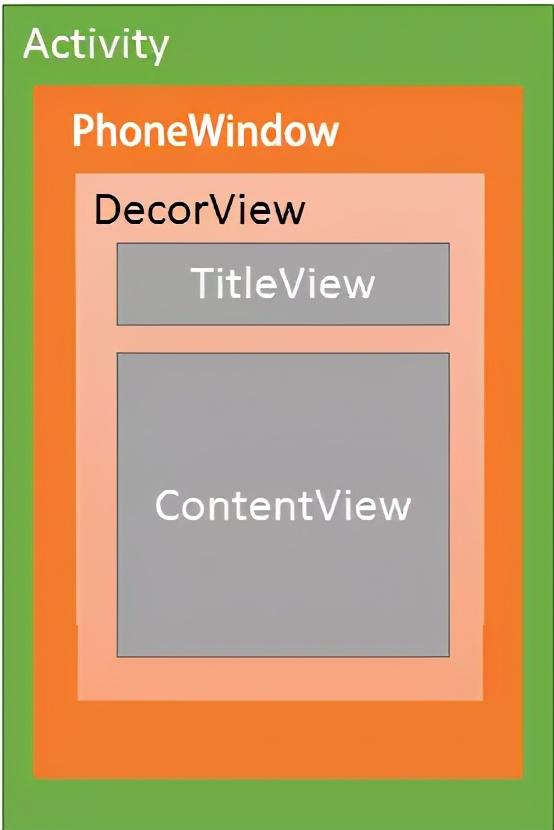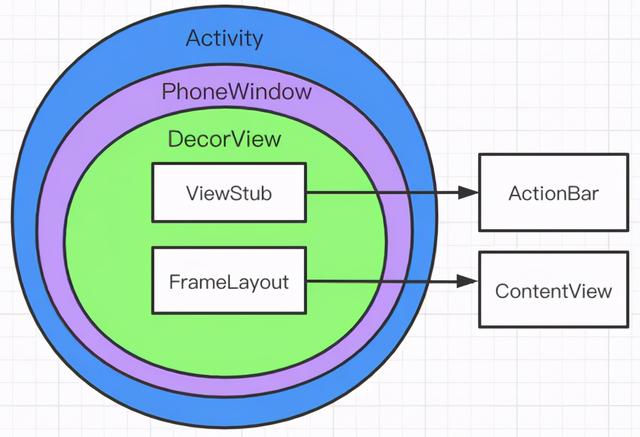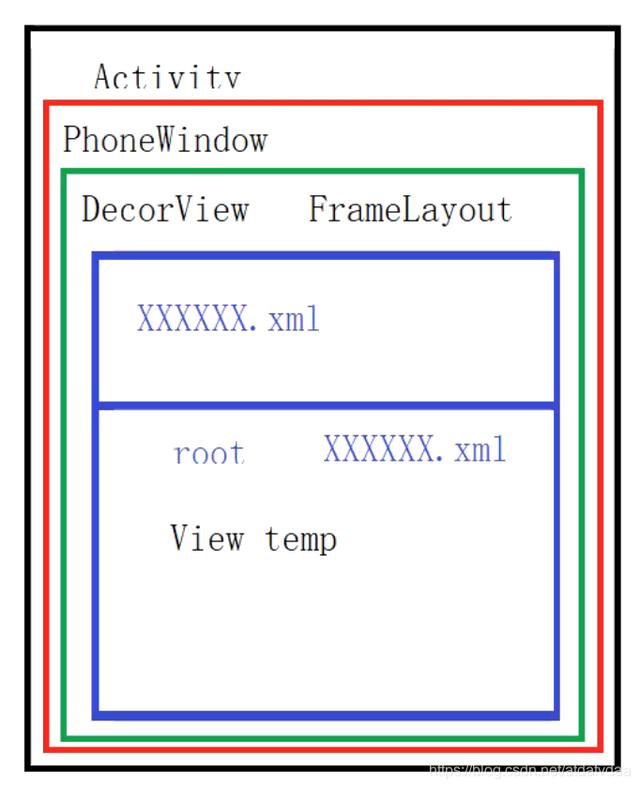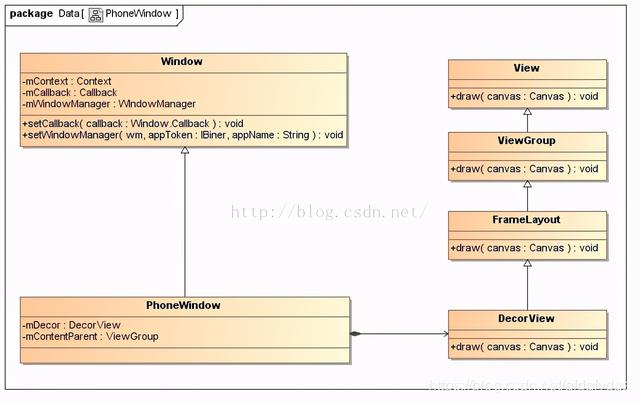一.首先看布局层次
看这么几张图




资源加载源码解析我们会发现DecorView里面包裹的内容可能会随着不同的情况而变化,但是在Decor之前的层次关系都是固定的。即Activity包裹PhoneWindow,PhoneWindow包裹DecorView。接下来资源加载源码解析我们首先看一下三者分别是如何创建的。
二.Activity是如何创建的
首先看到入口类ActivityThread的performLaunchActivity *** :
private Activity performLaunchActivity(ActivityClientRecord r, Intent customIntent) { ... ContextImpl appContext = createBaseContextForActivity(r); Activity activity = null; try { java.lang.ClassLoader cl = appContext.getClassLoader(); activity = mInstrumentation.newActivity( cl, component.getClassName(), r.intent); StrictMode.incrementExpectedActivityCount(activity.getClass()); r.intent.setExtrasClassLoader(cl); r.intent.prepareToEnterProcess(); if (r.state != null) { r.state.setClassLoader(cl); } } catch (Exception e) { ... }有句特别关键的代码,即
activity = mInstrumentation.newActivity(cl, component.getClassName(), r.intent); 1所以activity是Instrumentation类的newActivity *** 创建的,追踪过去,源码如下public Activity newActivity(ClassLoader cl, String className, Intent intent) throws InstantiationException, IllegalAccessException, ClassNotFoundException { String pkg = intent != null && intent.getComponent() != null ? intent.getComponent().getPackageName() : null; return getFactory(pkg).instantiateActivity(cl, className, intent); }追踪源码,可知getFactory *** 返回一个AppComponentFactory对象,然后调用AppComponentFactory的instantiateActivity *** ,继续追踪
public @NonNull Activity instantiateActivity(@NonNull ClassLoader cl, @NonNull String className, @Nullable Intent intent) throws InstantiationException, IllegalAccessException, ClassNotFoundException { return (Activity) cl.loadClass(className).newInstance(); }到这里就结束资源加载源码解析了,我们可以发现Activity是通过反射创建的。
复习反射
三.PhoneWindow的创建
我们还是回到ActivityThread的performLaunchActivity *** ,在刚刚展示的那一段的下面有如下部分代码
Window window = null; if (r.mPendingRemoveWindow != null && r.mPreserveWindow) { window = r.mPendingRemoveWindow; r.mPendingRemoveWindow = null; r.mPendingRemoveWindowManager = null; } // Activity resources must be initialized with the same loaders as the // application context. appContext.getResources().addLoaders( app.getResources().getLoaders().toArray(new ResourcesLoader[0])); appContext.setOuterContext(activity); activity.attach(appContext, this, getInstrumentation(), r.token, r.ident, app, r.intent, r.activityInfo, title, r.parent, r.embeddedID, r.lastNonConfigurationInstances, config, r.referrer, r.voiceInteractor, window, r.configCallback, r.assistToken);在activity.attach这个 *** 中,传入资源加载源码解析了一个Window对象,追踪这个attach *** ,里面有一句关键代码
mWindow = new PhoneWindow(this, window, activityConfigCallback);
1
此时就创建了PhoneWindow。所以我们可以知道,在Activity创建完之后,会为当前的Activity创建一个PhoneWindow对象。
三.DecorView的创建
DecorView的创建就不是performLaunchActivity *** 里面了,这次我们从Activity的setContentView的源码开始分析。下面的Activity的setContentView *** 的内容。
public void setContentView(@LayoutRes int layoutResID) { getWindow().setContentView(layoutResID); initWindowDecorActionBar(); }我们发现,Activity的setContentView实际是调用了PhoneWindow的setContentView *** ,跟踪源码。我们会首先进入Window抽象类,然后我们找其子类PhoneWindow,在里面找到setContentView ***
public void setContentView(int layoutResID) { if (mContentParent == null) { installDecor(); } else if (!hasFeature(FEATURE_CONTENT_TRANSITIONS)) { mContentParent.removeAllViews(); }当mContentParent为null时,会调用installDecor *** ,追踪进入
private void installDecor() { mForceDecorInstall = false; if (mDecor == null) { mDecor = generateDecor(-1); mDecor.setDescendantFocusability(ViewGroup.FOCUS_AFTER_DESCENDANTS); mDecor.setIsRootNamespace(true); if (!mInvalidatePanelMenuPosted && mInvalidatePanelMenuFeatures != 0) { mDecor.postOnAnimation(mInvalidatePanelMenuRunnable); } } else { mDecor.setWindow(this); }它调用了generateDecor *** ,追踪进入
protected DecorView generateDecor(int featureId) { // System process doesn't have application context and in that case we need to directly use // the context we have. Otherwise we want the application context, so we don't cling to the // activity. Context context; if (mUseDecorContext) { Context applicationContext = getContext().getApplicationContext(); if (applicationContext == null) { context = getContext(); } else { context = new DecorContext(applicationContext, this); if (mTheme != -1) { context.setTheme(mTheme); } } } else { context = getContext(); } return new DecorView(context, featureId, this, getAttributes()); }会发现generateDecor *** 会创建一个DecorView对象,并且作为返回值返回。再追踪DecorView
public class DecorView extends FrameLayout implements RootViewSurfaceTaker, WindowCallbacks会发现DecorView其实是一个FrameLayout 。到这就介绍完DecorView是如何创建的了
五.布局加载流程
我们回到PhoneWindow的installDecor *** ,再刚刚看的部分的下面,有(2692行)
if (mContentParent == null) {mContentParent = generateLayout(mDecor); 1追踪进入 protected ViewGroup generateLayout(DecorView decor) { // Apply data from current theme. TypedArray a = getWindowStyle(); if (false) { System.out.println("From style:"); String s = "Attrs:"; for (int i = 0; i < R.styleable.Window.length; i++) { s = s + " " + Integer.toHexString(R.styleable.Window[i]) + "=" + a.getString(i); } System.out.println(s); } mIsFloating = a.getBoolean(R.styleable.Window_windowIsFloating, false); int flagsToUpdate = (FLAG_LAYOUT_IN_SCREEN|FLAG_LAYOUT_INSET_DECOR) & (~getForcedWindowFlags()); if (mIsFloating) { setLayout(WRAP_CONTENT, WRAP_CONTENT); setFlags(0, flagsToUpdate); } else { setFlags(FLAG_LAYOUT_IN_SCREEN|FLAG_LAYOUT_INSET_DECOR, flagsToUpdate); getAttributes().setFitInsetsSides(0); getAttributes().setFitInsetsTypes(0); } if (a.getBoolean(R.styleable.Window_windowNoTitle, false)) { requestFeature(FEATURE_NO_TITLE); } else if (a.getBoolean(R.styleable.Window_windowActionBar, false)) { // Don't allow an action bar if there is no title. requestFeature(FEATURE_ACTION_BAR); } if (a.getBoolean(R.styleable.Window_windowActionBarOverlay, false)) { requestFeature(FEATURE_ACTION_BAR_OVERLAY); } if (a.getBoolean(R.styleable.Window_windowActionModeOverlay, false)) { requestFeature(FEATURE_ACTION_MODE_OVERLAY); } if (a.getBoolean(R.styleable.Window_windowFullscreen, false)) { setFlags(FLAG_FULLSCREEN, FLAG_FULLSCREEN & (~getForcedWindowFlags())); } if (a.getBoolean(R.styleable.Window_windowTranslucentStatus, false)) { setFlags(FLAG_TRANSLUCENT_STATUS, FLAG_TRANSLUCENT_STATUS & (~getForcedWindowFlags())); } if (a.getBoolean(R.styleable.Window_windowTranslucentNavigation, false)) { setFlags(FLAG_TRANSLUCENT_NAVIGATION, FLAG_TRANSLUCENT_NAVIGATION & (~getForcedWindowFlags())); } if (a.getBoolean(R.styleable.Window_windowShowWallpaper, false)) { setFlags(FLAG_SHOW_WALLPAPER, FLAG_SHOW_WALLPAPER&(~getForcedWindowFlags())); } if (a.getBoolean(R.styleable.Window_windowEnableSplitTouch, getContext().getApplicationInfo().targetSdkVersion >= android.os.Build.VERSION_CODES.HONEYCOMB)) { setFlags(FLAG_SPLIT_TOUCH, FLAG_SPLIT_TOUCH&(~getForcedWindowFlags())); } a.getValue(R.styleable.Window_windowMinWidthMajor, mMinWidthMajor); a.getValue(R.styleable.Window_windowMinWidthMinor, mMinWidthMinor); if (DEBUG) Log.d(TAG, "Min width minor: " + mMinWidthMinor.coerceToString() + ", major: " + mMinWidthMajor.coerceToString()); if (a.hasValue(R.styleable.Window_windowFixedWidthMajor)) { if (mFixedWidthMajor == null) mFixedWidthMajor = new TypedValue(); a.getValue(R.styleable.Window_windowFixedWidthMajor, mFixedWidthMajor); } if (a.hasValue(R.styleable.Window_windowFixedWidthMinor)) { if (mFixedWidthMinor == null) mFixedWidthMinor = new TypedValue(); a.getValue(R.styleable.Window_windowFixedWidthMinor, mFixedWidthMinor); } if (a.hasValue(R.styleable.Window_windowFixedHeightMajor)) { if (mFixedHeightMajor == null) mFixedHeightMajor = new TypedValue(); a.getValue(R.styleable.Window_windowFixedHeightMajor, mFixedHeightMajor); } if (a.hasValue(R.styleable.Window_windowFixedHeightMinor)) { if (mFixedHeightMinor == null) mFixedHeightMinor = new TypedValue(); a.getValue(R.styleable.Window_windowFixedHeightMinor, mFixedHeightMinor); } if (a.getBoolean(R.styleable.Window_windowContentTransitions, false)) { requestFeature(FEATURE_CONTENT_TRANSITIONS); } if (a.getBoolean(R.styleable.Window_windowActivityTransitions, false)) { requestFeature(FEATURE_ACTIVITY_TRANSITIONS); } mIsTranslucent = a.getBoolean(R.styleable.Window_windowIsTranslucent, false); final Context context = getContext(); final int targetSdk = context.getApplicationInfo().targetSdkVersion; final boolean targetPreL = targetSdk < android.os.Build.VERSION_CODES.LOLLIPOP; final boolean targetPreQ = targetSdk < Build.VERSION_CODES.Q; if (!mForcedStatusBarColor) { mStatusBarColor = a.getColor(R.styleable.Window_statusBarColor, 0xFF000000); } if (!mForcedNavigationBarColor) { mNavigationBarColor = a.getColor(R.styleable.Window_navigationBarColor, 0xFF000000); mNavigationBarDividerColor = a.getColor(R.styleable.Window_navigationBarDividerColor, 0x00000000); } if (!targetPreQ) { mEnsureStatusBarContrastWhenTransparent = a.getBoolean( R.styleable.Window_enforceStatusBarContrast, false); mEnsureNavigationBarContrastWhenTransparent = a.getBoolean( R.styleable.Window_enforceNavigationBarContrast, true); } WindowManager.LayoutParams params = getAttributes(); // Non-floating windows on high end devices must put up decor beneath the system bars and // therefore must know about visibility changes of those. if (!mIsFloating) { if (!targetPreL && a.getBoolean( R.styleable.Window_windowDrawsSystemBarBackgrounds, false)) { setFlags(FLAG_DRAWS_SYSTEM_BAR_BACKGROUNDS, FLAG_DRAWS_SYSTEM_BAR_BACKGROUNDS & ~getForcedWindowFlags()); } if (mDecor.mForceWindowDrawsBarBackgrounds) { params.privateFlags |= PRIVATE_FLAG_FORCE_DRAW_BAR_BACKGROUNDS; } } if (a.getBoolean(R.styleable.Window_windowLightStatusBar, false)) { decor.setSystemUiVisibility( decor.getSystemUiVisibility() | View.SYSTEM_UI_FLAG_LIGHT_STATUS_BAR); } if (a.getBoolean(R.styleable.Window_windowLightNavigationBar, false)) { decor.setSystemUiVisibility( decor.getSystemUiVisibility() | View.SYSTEM_UI_FLAG_LIGHT_NAVIGATION_BAR); } if (a.hasValue(R.styleable.Window_windowLayoutInDisplayCutoutMode)) { int mode = a.getInt(R.styleable.Window_windowLayoutInDisplayCutoutMode, -1); if (mode < LAYOUT_IN_DISPLAY_CUTOUT_MODE_DEFAULT || mode > LAYOUT_IN_DISPLAY_CUTOUT_MODE_ALWAYS) { throw new UnsupportedOperationException("Unknown windowLayoutInDisplayCutoutMode: " + a.getString(R.styleable.Window_windowLayoutInDisplayCutoutMode)); } params.layoutInDisplayCutoutMode = mode; } if (mAlwaysReadCloseOnTouchAttr || getContext().getApplicationInfo().targetSdkVersion >= android.os.Build.VERSION_CODES.HONEYCOMB) { if (a.getBoolean( R.styleable.Window_windowCloseOnTouchOutside, false)) { setCloseOnTouchOutsideIfNotSet(true); } } if (!hasSoftInputMode()) { params.softInputMode = a.getInt( R.styleable.Window_windowSoftInputMode, params.softInputMode); } if (a.getBoolean(R.styleable.Window_backgroundDimEnabled, mIsFloating)) { /* All dialogs should have the window dimmed */ if ((getForcedWindowFlags()&WindowManager.LayoutParams.FLAG_DIM_BEHIND) == 0) { params.flags |= WindowManager.LayoutParams.FLAG_DIM_BEHIND; } if (!haveDimAmount()) { params.dimAmount = a.getFloat( android.R.styleable.Window_backgroundDimAmount, 0.5f); } } if (params.windowAnimations == 0) { params.windowAnimations = a.getResourceId( R.styleable.Window_windowAnimationStyle, 0); } // The rest are only done if this window is not embedded; otherwise, // the values are inherited from our container. if (getContainer() == null) { if (mBackgroundDrawable == null) { if (mFrameResource == 0) { mFrameResource = a.getResourceId(R.styleable.Window_windowFrame, 0); } if (a.hasValue(R.styleable.Window_windowBackground)) { mBackgroundDrawable = a.getDrawable(R.styleable.Window_windowBackground); } } if (a.hasValue(R.styleable.Window_windowBackgroundFallback)) { mBackgroundFallbackDrawable = a.getDrawable(R.styleable.Window_windowBackgroundFallback); } if (mLoadElevation) { mElevation = a.getDimension(R.styleable.Window_windowElevation, 0); } mClipToOutline = a.getBoolean(R.styleable.Window_windowClipToOutline, false); mTextColor = a.getColor(R.styleable.Window_textColor, Color.TRANSPARENT); } // Inflate the window decor. int layoutResource; int features = getLocalFeatures(); // System.out.println("Features: 0x" + Integer.toHexString(features)); if ((features & ((1 << FEATURE_LEFT_ICON) | (1 << FEATURE_RIGHT_ICON))) != 0) { if (mIsFloating) { TypedValue res = new TypedValue(); getContext().getTheme().resolveAttribute( R.attr.dialogTitleIconsDecorLayout, res, true); layoutResource = res.resourceId; } else { layoutResource = R.layout.screen_title_icons; } // XXX Remove this once action bar supports these features. removeFeature(FEATURE_ACTION_BAR); // System.out.println("Title Icons!"); } else if ((features & ((1 << FEATURE_PROGRESS) | (1 << FEATURE_INDETERMINATE_PROGRESS))) != 0 && (features & (1 << FEATURE_ACTION_BAR)) == 0) { // Special case for a window with only a progress bar (and title). // XXX Need to have a no-title version of embedded windows. layoutResource = R.layout.screen_progress; // System.out.println("Progress!"); } else if ((features & (1 << FEATURE_CUSTOM_TITLE)) != 0) { // Special case for a window with a custom title. // If the window is floating, we need a dialog layout if (mIsFloating) { TypedValue res = new TypedValue(); getContext().getTheme().resolveAttribute( R.attr.dialogCustomTitleDecorLayout, res, true); layoutResource = res.resourceId; } else { layoutResource = R.layout.screen_custom_title; } // XXX Remove this once action bar supports these features. removeFeature(FEATURE_ACTION_BAR); } else if ((features & (1 << FEATURE_NO_TITLE)) == 0) { // If no other features and not embedded, only need a title. // If the window is floating, we need a dialog layout if (mIsFloating) { TypedValue res = new TypedValue(); getContext().getTheme().resolveAttribute( R.attr.dialogTitleDecorLayout, res, true); layoutResource = res.resourceId; } else if ((features & (1 << FEATURE_ACTION_BAR)) != 0) { layoutResource = a.getResourceId( R.styleable.Window_windowActionBarFullscreenDecorLayout, R.layout.screen_action_bar); } else { layoutResource = R.layout.screen_title; } // System.out.println("Title!"); } else if ((features & (1 << FEATURE_ACTION_MODE_OVERLAY)) != 0) { layoutResource = R.layout.screen_simple_overlay_action_mode; } else { // Embedded, so no decoration is needed. layoutResource = R.layout.screen_simple; // System.out.println("Simple!"); } mDecor.startChanging(); mDecor.onResourcesLoaded(mLayoutInflater, layoutResource); ViewGroup contentParent = (ViewGroup)findViewById(ID_ANDROID_CONTENT); if (contentParent == null) { throw new RuntimeException("Window couldn't find content container view"); } if ((features & (1 << FEATURE_INDETERMINATE_PROGRESS)) != 0) { ProgressBar progress = getCircularProgressBar(false); if (progress != null) { progress.setIndeterminate(true); } } // Remaining setup -- of background and title -- that only applies // to top-level windows. if (getContainer() == null) { mDecor.setWindowBackground(mBackgroundDrawable); final Drawable frame; if (mFrameResource != 0) { frame = getContext().getDrawable(mFrameResource); } else { frame = null; } mDecor.setWindowFrame(frame); mDecor.setElevation(mElevation); mDecor.setClipToOutline(mClipToOutline); if (mTitle != null) { setTitle(mTitle); } if (mTitleColor == 0) { mTitleColor = mTextColor; } setTitleColor(mTitleColor); } mDecor.finishChanging(); return contentParent; }分析源码和源码注释可以看出generateLayout *** 的核心功能是完成DecorView的布局加载,而且根据不同的主题样式会加载不同的系统默认布局。那么比如有FrameLayout布局,它如何加载到DecorView中呢?
在generateLayout *** 中,有这么一句
mDecor.onResourcesLoaded(mLayoutInflater, layoutResource);追踪进入
void onResourcesLoaded(LayoutInflater inflater, int layoutResource) { if (mBackdropFrameRenderer != null) { loadBackgroundDrawablesIfNeeded(); mBackdropFrameRenderer.onResourcesLoaded( this, mResizingBackgroundDrawable, mCaptionBackgroundDrawable, mUserCaptionBackgroundDrawable, getCurrentColor(mStatusColorViewState), getCurrentColor(mNavigationColorViewState)); } mDecorCaptionView = createDecorCaptionView(inflater); final View root = inflater.inflate(layoutResource, null); if (mDecorCaptionView != null) { if (mDecorCaptionView.getParent() == null) { addView(mDecorCaptionView, new ViewGroup.LayoutParams(MATCH_PARENT, MATCH_PARENT)); } mDecorCaptionView.addView(root, new ViewGroup.MarginLayoutParams(MATCH_PARENT, MATCH_PARENT)); } else { // Put it below the color views. addView(root, 0, new ViewGroup.LayoutParams(MATCH_PARENT, MATCH_PARENT)); } mContentRoot = (ViewGroup) root; initializeElevation(); }关键在这里
mDecorCaptionView = createDecorCaptionView(inflater); final View root = inflater.inflate(layoutResource, null); if (mDecorCaptionView != null) { ... mDecorCaptionView.addView(root, new ViewGroup.MarginLayoutParams(MATCH_PARENT, MATCH_PARENT)); }可以看到layoutResource作为参数,通过inflate *** 进行解析加载。然后作为参数,传入addView *** ,将布局挂载到上面。至此完成了DecorView的默认布局加载。如果是我们自己编写的布局是如何加载呢?再回到generateLayout的
mDecor.onResourcesLoaded(mLayoutInflater, layoutResource);,在此之后,有这么一句
ViewGroup contentParent = (ViewGroup)findViewById(ID_ANDROID_CONTENT);在DecorView执行onResourcesLoaded *** 加载完默认布局后,会查找Id为ID_ANDROID_CONTENT的控件(默认布局中的FrameLayout控件)并作为generateLayout *** 的返回值,我们回到setContentView *** 中,可观察到以下代码资源加载源码解析:
mLayoutInflater.inflate(layoutResID, mContentParent);所以,我们自己编写的布局是被加载到DecorView中Id为ID_ANDROID_CONTENT的控件上
六.总结
当Activity创建后会创建出一个PhoneWindow对象,当在Activity中调用setContentView时,实际上是调用了PhoneWindow的setContentView *** ,此时PhoneWindow会创建根布局DecorView,并根据主题样式,为DecorView加载对应的默认系统布局,在默认的系统布局中包含了一个Id为ID_ANDROID_CONTENT的控件,而我们自己编写的布局就是加载到这个控件中的。
相关文章
本站已关闭游客评论,请登录或者注册后再评论吧~
